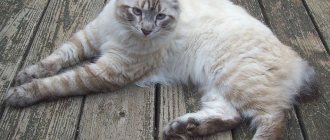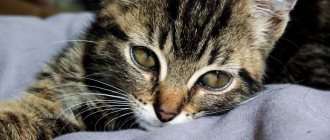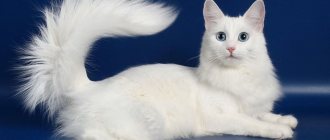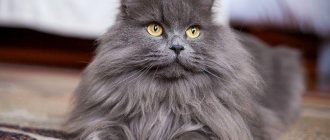The Javanese cat easily charms people's hearts with its friendly nature and natural grace. The breed is considered a long-haired variety of the Balinese cat. These cats are excellent companions for families with children or those who want their pet to be active and sociable. Javanese are also proud and wayward cats. Every year this breed is gaining more and more popularity.
In this article, we will talk about the standard and character of the Javanese cat breed. How much does a Javanese kitten cost and in which nursery can you buy it?
History of the Javanese cat breed
The Javanese breed has a rather controversial origin. The history of its origin and classification causes a lot of discussion among cat lovers and professional felinologists. There are two varieties of Javanese: European and American. There are minor visual differences between them that are visible only to specialists.
The American subspecies is the result of experimental work by two breeders: Anne Sandner and Maureen Davis. Their goal was to breed a Balinese cat with a variety of colors, not just the Siamese. As a result of breeding work with Balinese, Siamese and shorthaired Colorpoint Orientals, the first Javanese kittens appeared in 1978. A year later the breed was officially registered. American organizations (CFF, CFA, ACFA) consider the Javanese cat to be a variety of Balinese with an unconventional color.
According to the American theory of origin, the ancestor of the Javanese is the Balinese cat
According to the European version, the Javanese breed was obtained from a Siamese cat of seal-point color and an Abyssinian cat of sorrel (copper-red) color. At first, the new breed was called the British Angora. To avoid confusion with the Turkish Angora cat, it was renamed Javanese. But they began to breed it in the UK a little later than in America and Canada. European phenological communities (FIFe, WCF) position the Javanese as an oriental semi-longhair with colorful color options.
The Abyssinian cat took part in the European breeding of the Javanese.
The island of Java is very distantly related to both versions of origin. The connection is visible only in the similarity of Balinese cats with Javanese and the proximity of Java to the island of Bali.
After talking with cat lovers and asking them about the Javanese breed, we managed to find out that they do not even suspect the true origin of these cats. There is a theory, unconfirmed by facts, that a local aboriginal Javan cat with regular short hair, living in Indonesia on the island of Java, gave birth to long-haired offspring. All the Javanese supposedly originated from them. In my opinion, a logical version, but completely inconsistent with reality.
Character traits
They become attached to one family member and follow him around. Cats love to sit on their owner's lap or lie next to him. Representatives of the breed prefer to sleep in their master's bed. If you are against this, wean the kitten from a “tender” age.
The pet needs attention from the owner. If you don't give him time, he will start to play dirty tricks.
Unlike their Siamese ancestors, Javanese cats do not meow loudly. Their voice is quiet and melodic. Representatives of the breed love to purr.
Cats get along well with household members. They find a common language with children, provided that they do not squeeze or offend them. Cats may become aggressive if a child pulls the animal by the tail or otherwise causes discomfort.
Javanese cats are curious and strive to be in the thick of things. Not a single task in the house can be done without them. They are not easy observers, but they also try to take part in the process.
Cats are persistent: they will achieve what they want in any case. They are willful, but to a lesser extent compared to Siamese.
Javanese are smart and easy to train. Kittens quickly get used to the tray and feeding regime. The pet easily adapts to the owner’s lifestyle.
Animals are playful and active. This character trait is retained until old age. They "have fun" with any small objects that fall into their paws. It is better to hide jewelry, documents, and other valuables from your pet.
They love to explore their surroundings. The cat will climb both on and into the closet. Representatives of the breed are jumping and love to conquer heights.
The animals get along well with representatives of other breeds. They occupy a leading position. Two Javanese cats in the house are an explosive mixture that can turn everything upside down in a matter of minutes.
Description of the Javanese cat breed
The Javanese differs from the Balinese cats only in its variety of colors. Otherwise, the standards of these breeds are almost the same.
Appearance
An ordinary person who is not involved in phenological activities, seeing a Javanese cat for the first time, will mistake it for a wild animal. Although the breed was bred artificially, it looks completely natural. Its representatives have a medium-sized, lean, slightly elongated body with thin bones and well-developed prominent muscles. Since the breed belongs to the East, the Javanese is characterized by long, pointed lines of the body, which seems fragile, as well as grace, sophistication and softness.
The Javanese are characterized by long, pointed body lines.
The breed characteristics that a Javanese cat must meet are the following:
- a medium-sized, slightly elongated, proportional head with an elongated muzzle and well-defined cheekbones, a wedge-shaped (triangular) shape is created by almost straight lines running from the chin to the very tips of the ears, the profile is also straight (without humps and depressions), the chin and the tip of the nose form a vertical;
- the ears are large, widening at the base, pointed at the ends, spaced quite far from each other;
- the neck is long, thin and graceful;
- the nose is straight and long;
- eyes of medium size, slanting, almond-shaped, not sunken, but not protruding, located exactly to the contour of the head, but obliquely to the line of the nose, the distance between them is not less than the width of the eye;
- eye color can be all shades of green, white individuals have blue or multi-colored (green and blue);
- weight - from 2.5 to 5 kg;
- height at withers - 21–25 cm;
- body length - 40–45 cm;
- the tail is long and thin, tapering towards the end, length is at least 2/3 of the body length (approximately 30–35 cm);
- the limbs are high, refined and elegant (the hind legs are slightly longer than the front ones), the paws are medium-sized, oval.
The Javanese's head should be triangular in shape.
The coat is not very thick, of medium length, fits tightly to the body and has no undercoat - slightly shorter on the face and limbs, longer towards the back of the body. There is a pronounced collar on the neck. The maximum length of the fur is on the belly and in the form of a plume (fringe) on the tail. It feels very soft, smooth and silky to the touch.
Javanese eyes are usually green, and the color of the coat can contain all known shades
Javanese can have a wide variety of colors:
- single color (chocolate, white, black, silver, etc.);
- tortoiseshell;
- tabby (markings);
- party color (white with tortoiseshell or spotted);
- shaded (marble);
- brindle (striped);
- smoky, etc.
Despite their rather long coat, Javanese cats are considered hypoallergenic and can be kept in homes where allergy sufferers live.
Photo gallery: Javanese cats
Javanese can be one color
Javanese cats come in a light cream color.
In one litter there are kittens of very different colors
The colors can be very different, but the Javanese tail must be fluffy
The eyes of Javanese cats are almost always green.
Javanese cats definitely need a good play area.
Character
Along with their exotic appearance, Javanese cats have a very unique character. They are headstrong and stubborn, they like to keep the situation under control and take part in absolutely everything. A more active animal cannot be found in the cat kingdom. Insatiable curiosity and good intelligence allow the pet to easily open cabinet doors and pull out drawers, using his long and dexterous fingers. All small, valuable, fragile and breakable items should be placed in inaccessible and well-locked places. This breed is distinguished by enviable stubbornness and good memory. If the cat decides to find out what is in the cabinet under the TV, then she will do it. Maybe not today, but in a week she will definitely achieve what she wants.
Horse racing and endless races around the apartment are a completely normal pastime for the Javanese. Kittens are truly tireless and can frolic endlessly. With age, they calm down a little, but even an older cat can sometimes behave like a restless toddler. Javanese cats get along well with their fellow cats and other pets. Small children are also welcome to participate in their games. But they will not tolerate being used as a soft toy and may scratch.
Javanese cats cannot sit still for long periods of time, they need to run and play.
The Javanese become very attached to the owner, follow on his heels, rub against his legs, look over his shoulder, in general, they do everything possible and impossible to capture the owner’s attention and receive their portion of love and affection. They get bored alone, but unlike their close relatives, the Balinese, they tolerate it more easily. Left alone, they can easily find something interesting to do. But it is better to provide this activity to your pet in advance, otherwise he may use objects that are not entirely suitable for play. The ideal solution would be to purchase a good multifunctional gaming complex, or better yet, make a similar structure to order. It is necessary to provide for the presence of high shelves and beds, ladders and tunnels, toys, scratching posts and houses for shelter.
All owners note the excellent hunting qualities of the Javanese. Mice, rats and other rodents are the most desirable toys and prey.
The talkative nature of Javanese cats is their distinguishing feature. They communicate their thoughts on this or that matter to their owner and respond with meows to all phrases addressed to them. Animals are easy to learn, train a little and immediately understand the routine. It is highly not recommended for people of a calm and melancholic nature to have these energetic and active pets; with such an animal they will not be able to sit quietly in front of the TV. This breed is also not suitable for pedantic neatness, because perfect order in the house will only be a dream. Owners of small apartments should opt for a calmer cat breed, otherwise everything in the room will always be turned upside down.
Video: Javanese cat
Standard
The breeds are accepted by the associations CFA, FIFE, TICA and others. The standards of Balinese and Javanese are the same in everything except colors:
- The animal is flexible, strong, harmoniously built. It has a long body of medium size, slender and graceful. Thin bones go well with strong muscles. Hips should not be wider than shoulders. Average weight – 2.5–5 kg, height – 25–28 cm;
- the head is of medium size, proportional to the body, in the shape of a long tapering wedge that starts from the nose and “spreads” in straight lines to the base of the ears;
- clean, shiny eyes, almond-shaped, medium in size, set shallowly, but not bulging. The distance between them should not be less than the length of one eye. Strabismus is unacceptable. The tilt of the eyes towards the nose is in harmony with the lines of the wedge and ears;
- the nose is long and straight, continuing the line of the forehead. The stop (curve of the nose) is minimal or not pronounced;
- the ears are very large, pointed, with a wide base and continue the line of the wedge;
- there is no break on the sideburns;
- if you smooth down the whiskers and fur on the face, the bone structure becomes obvious;
- the skull is flat, in profile a straight line should be visible from the top of the head to the tip of the nose, there is no bulge above the eyes;
- The jaw and chin are of medium size, not massive, but noticeable. The tip of the chin is in line with the tip of the nose;
- the neck is long, slender, thin and graceful;
- legs with long and thin bones, the hind legs are slightly longer than the front ones;
- the feet are graceful, small, oval in shape. There are five toes on the front paws and four on the hind paws;
- the tail is thin and long, tapering towards the tip;
- The coat is semi-long, silky, soft, without undercoat; due to its close fit to the body, it may seem shorter than it actually is. The longest hair, similar to a train, is on the tail.
Javanese that fully comply with the standard are rare
Color
The standard color requirements are:
- Darkening of the fur on the body is undesirable. Some allowances may be made for older animals with dark colored points, since Javanese darken with age. But there should always be a contrast between the color of the points and the body;
- the color of the tail, paws, feet, face mask and ears is clear and easy to identify;
- the shades are the same on all points;
- the mask covers almost the entire muzzle, including the whisker pads, except for the upper part of the head, and is connected to the point on the ears;
- points should not have ticking or white hairs;
- Any eye color, but in harmony with the coat color.
There are high demands on the color of Javanese
The following color options are allowed by the standard:
- red point;
- cream point;
- fawn point;
- cinnamon point;
- all link points;
- all cake points;
- all party color points (blue cream point, lilac cream point, seal cake point).
Javanese dogs can also be fully solid, tortoiseshell, tabby and other colors, they are not recognized by the CFA alone. It is allowed to cross Javanese cats with shorthaired color-point, Siamese, Balinese cats, as well as with Oriental shorthair and longhair.
Purchasing a Javanese kitten
Since the Javanese cat breed is not very popular in Russia, finding a purebred kitten is not at all easy. There are several specialized nurseries that breed Javanese.
Criterias of choice
Javanese cats differ from their closest relatives, the Balinese, in a huge variety of colors. Therefore, it will be quite difficult to make a mistake with this. While the former come only in Siamese colors, the latter come in very different colors.
You should only buy a kitten from a nursery or a reliable breeder. First, you should definitely get to know the baby’s parents and study their pedigree. They must meet all breed standards. The cost of a baby is determined by its class, color and gender (cats are cheaper). The most expensive animals will be those intended for exhibition activities (from 100 thousand rubles), a kitten with defects in appearance (a crooked tail, a different eye color, etc.) can be bought very inexpensively, but it is subject to mandatory castration or sterilization and is unsuitable for breeding.
The kitten should look healthy
When choosing a pet, you need to pay attention to external signs:
- the kitten should be very active, playful and agile;
- the fur is clean, soft and healthy;
- eyes and ears that are clean and without any discharge;
- soft tummy that does not cause pain in the animal when touched;
- straight, white teeth.
Javanese cats often give birth to deaf kittens, so before purchasing a baby you need to check its reaction to noise and sounds.
Sometimes there are deaf kittens in a litter
We picked up a kitten on the street under a fence. He squeaked so much that he could be heard even through tightly closed windows. We didn’t immediately realize that he was deaf. At first they thought that he was just taking a long time to get used to the new environment. The cat turned out to be an albino, there was not a single dark spot on him, and he was completely deaf. Oddly enough, his own deafness did not interfere with him at all; he lived in his own world and even managed to catch mice. But communication with such a pet cannot be called full-fledged contact. He did not respond to his nickname and was always in a certain prostration. He lived a long and happy life. But then, when we already had a normally hearing animal, for a very long time we admired the fact that the cat comes running when you call it.
At what age is it better to adopt a kitten?
The optimal age is 3–3.5 months . At this time, the kittens are already completely independent and quickly adapt to their new environment.
Javan kittens are usually given away after three months.
Diseases
From their Siamese ancestors, Javanese cats inherited not only external beauty and flexibility, but also poor health. Unfortunately, most pathologies cannot be cured.
- Asthma. Symptoms: coughing, loud snoring, attacks of suffocation, breathing through the mouth, wheezing. The use of inhalers during attacks, air humidification and frequent wet cleaning in the living area, and compliance with other veterinarian recommendations are required.
- Amyloidosis. Symptoms: lack of appetite, weight loss, frequent urination, thirst, apathy, abdominal dropsy, diarrhea or constipation, jaundice on the skin and mucous membranes. The condition can be alleviated with medication.
- Hyperthyroidism. Pathology of the thyroid gland. Symptoms: the cat is losing weight, drinks a lot and often runs to the toilet, her hair begins to fall out severely, diarrhea and tremors appear, lethargy, shortness of breath, apathy. Treatment: potassium, corticosteroids.
- Myasthenia. Due to the obstruction of nerve impulses, the cat's muscles weaken. Treatment: medication or surgery.
- Epilepsy. Cause: dysfunction of the nerves of the brain. Symptoms: the animal suddenly loses consciousness; freezes, looking at one point; her muscles contract convulsively. The disease cannot be cured, but regular use of anticonvulsants makes the animal’s life much easier.
Javanese cats often suffer from digestive problems. You, as the owner, should pay primary attention to the proper nutrition of the animal.
Keeping a javanese pet
In terms of maintenance, Javanese cats are no different from ordinary cats. There are no particular difficulties with them, but there are several important points to consider.
Nutrition
You can feed Javanese cats with ready-made premium and super premium dry and wet food or create a diet made from natural products.
Quantity and composition of food
The average recommended amount of food for these active cats should be approximately 35–40 g per kilogram of live weight. It is not recommended to overfeed Javanese dogs, as they are prone to overeating and obesity.
Natural nutrition should be based on the following products:
- lean meat (beef, turkey, rabbit, chicken);
- low-fat dairy products (cottage cheese, sour cream, kefir);
- sea fish;
- quail eggs;
- cereal porridges (oatmeal, buckwheat, barley, rice, etc.);
- greenery;
- fruits;
- boiled vegetables (carrots, zucchini, potatoes, etc.).
Javanese need to be fed raw meat.
Since all cats are carnivores, the basis of their diet should be meat. It should be given raw, so it is better absorbed and more nutrients and vitamins are retained. But before eating, the meat must be frozen well (at least 12 hours), and then poured with hot water. The thawed and cooled product is given to the pet.
On sale you can find specialized food intended for Oriental and Siamese cats. They are most suitable for the Javanese breed.
Special attention should be paid to the freshness of food, since Javanese cats sometimes have problems with the gastrointestinal tract.
How many times a day should you feed your pet?
The frequency of feeding is determined by the age of the animal:
- from 2 to 3 months - 6 times a day;
- from 4 to 6 months - 4–5 times a day;
- from 6 to 12 months - 3 times a day;
- after a year they switch to two meals a day (morning and evening).
Little Javanese are fed wet food for Siamese kittens
As the animal grows, the serving size gradually increases.
The role of a balanced diet in cat health
Since Javanese cats are particularly mobile and active, the role of proper and balanced nutrition is very important for them . Poor feeding can lead to various ailments and diseases. It is necessary to supplement the diet with mineral and vitamin complexes containing various amino acids, magnesium, calcium, phosphorus, zinc, vitamins C, A, D and group B. It is very useful to feed your pet fresh brewer's yeast (¼ teaspoon per day).
Professional food has a balanced composition and already contains all the necessary substances.
With a natural diet, cats must be given vitamins.
Even the simplest and most unpretentious cats can have health problems from a lack of vitamins and minerals. Once upon a time, a yard cat came to the workshop at the factory, and we all fed it. In winter, hair came out on his face above his eyes, and two hairless tracks formed up to his ears. Out of ignorance, they first tried to treat him for deprivation, but there was no point. In the summer, when greenery appeared, everything returned to normal, and the fur grew. Apparently, the cat himself filled in the gaps in feeding.
Appearance care
Maintaining the appearance of Javanese cats in excellent condition is not difficult at all. Care does not take much time.
Combing
The Javanese's coat is quite long, but it is easy to care for, since it does not have an undercoat and is not prone to matting. It is enough to comb your pet once a week to remove dead hair. A special comb is used to care for long hair.
You need to periodically comb out dead hairs with a special brush or comb.
Bathing
They try to bathe Javanese cats as rarely as possible and only when necessary. They do an excellent job of cleaning their fur on their own and lick themselves very thoroughly. Javanese skin is dry, very delicate and sensitive; after washing it takes a long time to restore its protective properties. Therefore, when bathing, be sure to use a special pet shampoo for animals with fine hair.
Ear care
Increased activity and excessive curiosity, as a result of which the pet often penetrates into not very clean and dusty places (under the sofa, on the closet, etc.), contribute to the fact that its large ears collect a fair amount of dirt. The ears should be cleaned 2-3 times a week using cotton pads soaked in hydrogen peroxide, chlorhexidine or a special ear care solution .
The ears are wiped with a special animal ear care product.
Eye care
The pet's eyes are wiped every morning. To do this, use cotton swabs and ordinary boiled water. You can take decoctions of various herbs (calendula, chamomile, etc.) or ready-made pharmaceutical solutions.
Javanese eyes can be wiped with special wet wipes.
All major shopping centers, pet stores and veterinary pharmacies sell wet wipes for the care of ears and eyes for animals.
Nail care
Nails need to be shortened every 2-3 weeks. It is better to purchase special scissors (nail clipper). To independently remove dead horny plates, a javanese needs a good scratching post.
Nails need to be trimmed every 2-3 weeks
Dental care
To avoid possible problems with teeth and gums, it is recommended to brush your pet’s teeth once a week using a special paste that does not need to be rinsed off and a soft small brush.
Javanese cats' teeth are brushed once a week with a special toothpaste for animals.
Toilet
Any litter box will be useful for the Javanese cat; in this regard, it is completely undemanding. The choice of filler depends on the personal wishes of the owners.
For small kittens who like to play with litter, it is recommended to first add wood pellets. They will not cause harm to health if the baby accidentally swallows them.
Walks
Due to their excessive activity, Javanese dogs love to walk and quickly get used to a harness and leash . After walks, you need to wash your paws (wipe with special napkins). Once every 2-3 months, the pet must be given anthelmintic drugs.
Javanese cats love to walk, but it is better to walk them on a leash.
Diet
The diet of these cats should be balanced, high in protein and low in fat. Food can be either natural or in the form of ready-made food
In the first case, it is important to remember that all cats are primarily carnivores and the basis of their diet should be meat, which is better digested raw.
But given the realities of life, for the purpose of disinfection, it is still better to subject it to light heat treatment or at least freeze it. In addition to meat, they give fillets of sea fish, a certain amount of stewed cereals and vegetables, as well as low-fat kefir and cottage cheese, if the animal is not lactose intolerant. The pathology is immediately noticeable by loose stools.
If the diet is based on ready-made food, it is better to give preference to well-known manufacturers and food of at least premium class, which meet quality standards. Due to the high activity, it is recommended to add vitamin-mineral complexes and feed additives containing sodium, calcium, phosphorus, magnesium, vitamins A, C, B1 and D to the main diet.
Defects of Javanese cats
The Javanese cat did not receive very good heredity from its Siamese ancestors . This breed is characterized by some defects and pathologies.
Tendency to diseases
Javanese are susceptible to the following diseases:
- congenital heart defects;
- pathologies of the upper respiratory tract (asthma, etc.);
- problems with the gastrointestinal tract;
- neurological ailments (depression, neurosis);
- amyloidosis (protein metabolism disorder);
- kidney problems;
- strabismus.
Some of these problems are genetic and run in families, such as heart disease . To prevent the development of dangerous diseases, your pet needs to be shown to the veterinarian regularly (1-2 times a year) and thoroughly examined. With proper maintenance and good care, Javanese cats live up to 14–15 years.
Javanese people have strabismus, which in most cases goes away on its own after reaching the age of one year.
The health and well-being of the animal must be closely monitored. Warning signs and reasons to contact a veterinary clinic are the following symptoms:
- deterioration of coat condition;
- discharge from the nose and eyes;
- refusal of food and loss of appetite;
- lack of usual activity and general lethargy;
- atypical and strange behavior of the cat.
Defects in appearance
Disadvantages in the appearance of Javanese cats are:
- squat build and short legs;
- short body;
- wide or round rather than triangular head shape;
- short or wide muzzle;
- not slanted, but small or round eyes;
- not a straight profile, but with a bend;
- short hair;
- not very long hair on the tail.
Inadmissible defects that exclude an animal from participating in exhibitions include a hook on the tip of the tail and double coat (presence of undercoat).
Feeding
The health of a pet and its longevity primarily depends on nutrition. Professional breeders recommend using good quality ready-made food. For Javanese cats, the problem of overeating is relevant. To balance the diet not only in composition, but also in calorie content, you can use dry and canned food.
Natural products are also sometimes needed to provide variety. In addition, it makes sense to leave sprouted grass freely available - wool is not a problem, but prevention will not hurt.
https://youtube.com/watch?v=kYU2FCwMYPA
The cheerful and active oriental breed will delight you with a gentle and pleasant voice. Well, the certain independence of Javanese cats will pleasantly surprise lovers of extreme oriental exterior.
Breeding Javanese cats
The Javanese are not yet very popular in Russia. They are most widespread in the USA and Canada. These cats are mainly bred in nurseries specializing in Balinese and Oriental breeds.
Special nurseries are engaged in breeding Javanese cats.
Criteria for choosing a partner
When breeding Javanese cats, it is extremely important to take into account heredity. All animals with defects in appearance are excluded. All developmental pathologies and genetic diseases are also taken into account.
When selecting a partner, pay attention to the following points:
- compliance of the exterior with all breed standards;
- absence of genetic pathologies;
- healthy and active appearance;
- vaccination (done at least 2–3 weeks before mating) and anthelmintic treatment;
- presence of pedigree and breeding clearance.
It is advisable that one of the animals is already untied, so there is a greater chance of a successful mating. Before this, both partners' claws are trimmed so that they do not injure each other. The cat is brought to the cat's territory and left for several days (3–5). If possible, then you need to look at the already born offspring. Sometimes purebred Javanese females are bred with Oriental and Balinese cats.
At what age should you give your pet for the first mating?
Javanese fish reach sexual maturity at approximately 12 months. It is not recommended to breed animals before this. The cat’s body may not be fully formed for pregnancy and childbirth, so veterinarians advise mating females after the second heat, or better later (after two years). Cats can be bred when they reach one and a half years old.
How often can a cat give birth?
There are two opposing points of view on the question of how often a cat can give birth. One side adheres to the principle of naturalness and believes that the female should bear offspring after each heat (from 3 to 5 times a year). The other side takes the position that the animal does not have time to fully recover, and this inevitably negatively affects both its health and the health of the kittens. They believe that it is optimal and safe for a cat to give birth once every 1.5–2 years.
It is recommended that a cat give birth no more than 1–2 times a year.
Relationships with people
The Javanese cat is smaller than average and has an unusual appearance, also due to the structure of its coat. The ears are large, the head is wedge-shaped, the body is slightly elongated, the paws are slender and of medium length. The cat as a whole gives the impression of a rather graceful pet of small size, with a fluffy tail, and the amount of hair at the tip of the tail is much greater than at its beginning. Deep, blue almond-shaped eyes complete the look.
The kindness and sharp intelligence of these cats, combined with patience and affection, make them an excellent choice for literally every loving owner - from single people to large families.
Castration and sterilization of Javanese cats
Animals that have flaws and defects in appearance, as well as various genetic disorders, are excluded from breeding. They must undergo sterilization or castration operations.
At what age is it recommended to castrate an animal?
There is no clear answer to this question. Theoretically, castration and sterilization operations can be performed from one and a half months until old age. Abroad, early implementation of such procedures is practiced. But veterinarians believe that the time to begin these manipulations depends on the physiological maturity of the animal. When the first signs appear (anxiety, aggression, territory marking, etc.), you should immediately operate on your pet. The operation requires timely implementation while behavioral habits have not yet been fully formed.
Males are operated on after 10 months, and females at 8–12 months. It is better to have time to carry it out before the first heat, at least up to two years.
Sterilization or castration surgery performed too early can cause developmental delays in the animal. It may be stunted and remain small and petite.
Caring for your pet after surgery
Good post-operative care includes the following:
- until the pet has recovered from anesthesia, a protective postoperative blanket and collar are put on it so that it does not lick the stitches;
- provide the animal with accommodation in a quiet and peaceful place;
- sutures are treated once a day with disinfectants (hydrogen peroxide, chlorhexidine, etc.);
- you cannot feed your pet for 10–12 hours after surgery;
- To prevent the seams from coming apart, it is necessary to limit the animal’s mobility.
After castration or sterilization, the animal must be wearing a post-operative blanket and collar.
In case of any alarming or suspicious situations (stitches look bad, the pet refuses food for a long time, etc.), you should contact a veterinary clinic for advice.
Care instructions
Grooming this short-haired cat requires minimal time and effort. The main task is to choose the right diet, care for the coat and carry out mandatory hygiene procedures.
Wool
The fur needs to be combed regularly, and the animal is unlikely to resist it. Once a week will be enough. But remember that the procedure will need to be carried out 2 times more often during molting.
Claws
Claw trimming is done to prevent the animal from injuring its owner or damaging the furniture in the house. There are several ways to achieve the goal:
- Trim nails regularly using special clippers.
- Purchase silicone claw covers that fit over the sharp edge of an animal’s claw and prevent unwanted scratches.
- Buy a scratching post. Perhaps this method is the most optimal and natural.
You need to get used to a scratching post from an early age, so take care of purchasing one in advance.
Ears
Once every 2 weeks, your cat's ears need to be cleaned. To do this you will need regular cotton swabs.
There is nothing complicated in the procedure, but it is extremely important not to damage the animal’s auricle
The precautions are as follows:
- It is better to carry out the procedure in the evening, when the cat is no longer so energetic and will not resist much;
- Fix the animal's head well. For these purposes, you can wrap the cat in a towel.
Remember, any careless movement can lead to ear injury. Take your time to complete the process as quickly as possible
Bathing
You should not wash your cat too often - this breed does not need frequent water treatments and does not like them. It is enough to bathe the animal as it gets dirty and about once every 2-3 months for preventive purposes.
Naturally, this rule applies to pets that live at home. If the cat is walking, then you will have to wash it more often. In this case, you should use a special shampoo for cats.
As an exception, you can use baby shampoo if you did not have time to purchase a special product. However, this method is unsafe for the animal, because it can cause allergies and dry skin.
Teeth
For oral hygiene, you need to brush your teeth once every one and a half to two weeks. Because The Havana breed is prone to diseases of the gums and teeth; this rule should not be broken.
Table: pros and cons of the Javanese cat breed
| pros | Minuses |
|
|
What is the price?
Taking into account the fact that rare nurseries professionally breed these cats, the cost of the animals is quite high. Thus, for a Javanese kitten in Russia you will have to pay about 40,000 rubles. In Ukraine and Belarus, it is generally problematic to purchase this fluffy dog, since there is not a single officially registered nursery. But buying such an expensive animal from private individuals is quite a risky endeavor.
Maine Coon photo gallery see here.
Interesting Facts
During the short period of existence of the breed, many interesting things have been associated with it:
- Javanese cats were named after the island of Java, although they have nothing to do with it. They began to be called that because of their relationship with the Balinese and because of their “oriental” appearance.
- At first, the Javanese were recognized as a separate breed. But in 2008 they were declared a variety of Balinese cats.
- Javanese breeds are allowed to be crossed with long-haired Orientals, Siamese and Balinese.











